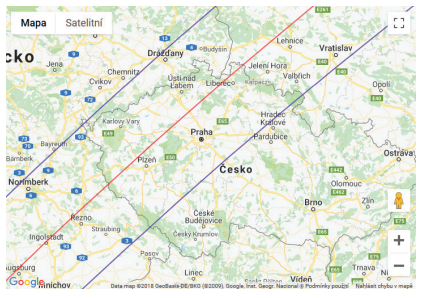- Practical Exercise 1 DEMONSTRATION OF A SOLAR ECLIPSE
- Practical Exercise 2 SOLAR ECLIPSE MODEL IN THE FIELD
- Practical Exercise 3 APPARENT SIZE OF THE SUN AND MOON IN THE SKY – TYPES OF SOLAR ECLIPSES
- Practical Exercise 4 OBSERVATION OF A TOTAL SOLAR ECLIPSE FROM OTHER PLANETS
- Practical Exercise 5 THE NEAREST SOLAR ECLIPSES
Practical Exercise 5: THE NEAREST SOLAR ECLIPSES
Based on the information found on the Internet, compile a list of upcoming solar eclipses until 2025. For each eclipse, indicate when it will occur, what type of eclipse it will be and from which territory it will be observable. Try to find on the map which states the belt of totality will cross. We recommend using the NASA website: https://eclipse.gsfc. nasa.gov/eclipse.html.
Using this or other websites, try to find out when a total solar eclipse will be visible from the territory of the Slovak Republic and where the belt of totality will lead. You can do the same for the next total eclipse observable from the territory of Bratislava.
Objective of activity
The aim of this activity is for pupils to learn to search for information on the Internet and to get an idea of the frequency of the solar eclipse phenomenon and the territory that will hit a specific total / annular solar eclipse (the size of the belt of totality / annularity).
Methodical notes for the teacher
• All the information you need to complete the exercise can be found on the NASA website https://eclipse.gsfc.nasa.gov/eclipse.html. ÚData for world eclipses for the coming years are directly in the table from which the links to the maps lead. To search for eclipses in the Slovak Republic, it is advisable to use the section “Five Millennium Catalogue of Solar Eclipses” and search in it according to geographical coordinates. However, information on the date of the next eclipse in the Slovak Republic can also be found on many other websites and only the course of the belt of totality can be traced here. To search for eclipses in Bratislava, it is useful to use the script “JavaScript Solar Eclipse Explorer” https://eclipse.gsfc.nasa.gov/JSEX/JSEX-EU.html. We couldn't find this information on another site.
• The website is, of course, in English. However, we believe that the vocabulary used is so limited that this should not be a problem.
Sample answer
| 6. 1. 2019 | partial | North-east Asia, North Pacific Ocean |
| 2. 7. 2019 | total | South Pacific Ocean, Chile, Argentina |
| 26. 12. 2019 | annular | Saudi Arabia, India, Sumatra, Borneo |
| 21. 6. 2020 | annular | Central Africa (Democratic Republic of the Congo, South Sudan, Ethiopia, Eritrea), South and East Asia (Yemen, Saudi Arabia, Oman, Pakistan, India, China, Taiwan), Pacific Ocean |
| 14. 12. 2020 | total | South Pacific Ocean, Chile, Argentina, South Atlantic Ocean |
| 10. 6. 2021 | annular | Northern Canada, Greenland, eastern Russia |
| 4. 12. 2021 | total | Antarctica |
| 30. 4. 2022 | partial | south-eastern Pacific Ocean, south of South America |
| 25. 10. 2022 | partial | Europe, north-east Africa, Middle East, West Asia |
| 20. 4. 2023 | hybrid | Indonesia, Australia, Papua New Guinea |
| 14. 10. 2023 | annular | Western USA, Central America (Mexico, Guatemala, Honduras, Nicaragua, Costa Rica, Panama), Colombia, Brazil |
| 8. 4. 2024 | total | Mexico, central USA, eastern Canada |
| 2. 10. 2024 | annular | southern Chile, southern Argentina |
| 29. 3. 2025 | partial | north-west Africa, Europe, northern Russia |
| 21. 9. 2025 | partial | South Pacific Ocean, New Zealand, Antarctica |

The future total solar eclipse visible from the territory of the Czech Republic will occur on October 7, 2135. The belt of totality will hit the northern and north-eastern part of the republic and will run north of the cities of Ústí nad Labem, Pardubice and Olomouc, see the picture.

The future total solar eclipse visible from the territory of Prague will occur on April 20, 2433. The belt of totality will hit the western, central and northern part of the republic and will run north of Strakonice, Kolín and Broumov, see picture.


